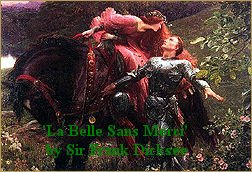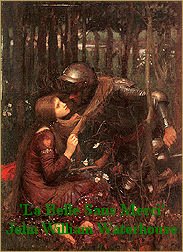Researching Arthurian Legends, Online
Mark Young
 The legends of King Arthur have been written and rewritten, translated to and from many different languages and applied to many different categories of literature throughout the centuries. A simple search on the Internet, using the keyword "Arthurian," can turn up hundreds of pages of information on the subject. It is very easy to be overwhelmed by this information, which can be of an historical nature as well as a fictional one. Therefore, it is very helpful to start with basic information, such as the gist of the story as a whole. A good source is always a notable source. If there are any historical implications in the source, they should be well documented. Once the basic story of King Arthur and his circle of chivalrous knights is understood, it is much easier to decide what type of information is relevant, and how many years one wants to spend researching the subject! As previously mentioned, there are many perspectives on the story, and there are many unknowns. It is legend, after all.
The legends of King Arthur have been written and rewritten, translated to and from many different languages and applied to many different categories of literature throughout the centuries. A simple search on the Internet, using the keyword "Arthurian," can turn up hundreds of pages of information on the subject. It is very easy to be overwhelmed by this information, which can be of an historical nature as well as a fictional one. Therefore, it is very helpful to start with basic information, such as the gist of the story as a whole. A good source is always a notable source. If there are any historical implications in the source, they should be well documented. Once the basic story of King Arthur and his circle of chivalrous knights is understood, it is much easier to decide what type of information is relevant, and how many years one wants to spend researching the subject! As previously mentioned, there are many perspectives on the story, and there are many unknowns. It is legend, after all.
One good place to start is an online encyclopedia. The online version of Encarta is a notable source of information, for example. Its set of navigational tools isn't quite as robust as some site's tools, but a simple search for "Arthurian Legend" will produce a page containing an introduction to Arthurian legend. This introduction gives a brief, yet comprehensive description of the story and some of the first known and recorded references to the legends.
Under the section entitled The Legend is a more in-depth version of the story. It is very helpful in that it notes where some versions of the story might differ. It also contains links to descriptions of some of the characters and places within the story. It is approximately two pages long and spans from the time of King Arthur's conception to his death, or his abduction to Avalon, whechever the reader prefers to believe.
Under the section entitled Literary Treatment of the Legend are several references suggesting how the legends evolved over time. The time period spans from the sixth century to the present and includes references and links to some of the known texts containing allusions or references to King Arthur and his reign. It also provides brief tidbits of information about the authors of the texts and, for some, cultural aspects of their time that may have inspired their writings.
 The online encyclopedia Britannia contains a more thorough list of topics on this subject. Once the overall story, and some of the basic history surrounding it, is understood, it is much easier to navigate and digest some of the more in-depth information contained here. Included in this site are links to excerpts from some of the texts mentioned in Encarta, such as De Excidio Britanniae written by Gildas, a sixth-century British monk, and Historia Brittonum, written by Nennius, a ninth-century Welsh monk/historian. Both of these texts are believed to play a role in the origins of the Arthurian legends. The site also includes links to other early British historical sites, Arthurian biographies, maps and much more, all of which help to give a cultural overview of the early days of the legends.
The online encyclopedia Britannia contains a more thorough list of topics on this subject. Once the overall story, and some of the basic history surrounding it, is understood, it is much easier to navigate and digest some of the more in-depth information contained here. Included in this site are links to excerpts from some of the texts mentioned in Encarta, such as De Excidio Britanniae written by Gildas, a sixth-century British monk, and Historia Brittonum, written by Nennius, a ninth-century Welsh monk/historian. Both of these texts are believed to play a role in the origins of the Arthurian legends. The site also includes links to other early British historical sites, Arthurian biographies, maps and much more, all of which help to give a cultural overview of the early days of the legends.
Other reliable sources of information on the Internet may be pages written and/or maintained by a notable college. These often contain many helpful links as well as extensive bibliographies for further research. One such site, maintained and/or authored by Thomas Green of Exeter College in Oxford, England, contains a wealth of information. His site includes historical information surrounding the time period of the Arthurian legends, character analyses, bibliographical sources and links to other Arthurian sites. Another extremely helpful attribute of his web site is a list of links to electronic libraries including the Cambridge University Library, The British Library and the Oxford Text Archive, among others. He also provides links to archeological and historical information pertaining to early England.
Of course, no web research would be complete without some of the interesting graphical effects available with today's technology. These sites are normally saved for last, as it is best to get information from known reliable sources in order to form an opinion on other sources which may not be as known or reliable. One site of interest might be the site developed by Grobius Shortling, entitled The Dark Ages: King Arthur and Others. Within the pages of this site are some interesting graphical effects, pictures and helpful references to both historical and fictional books, critiqued by Grobius. His text includes opinions about some of the characters within the story of King Arthur. It is always helpful to get other opinions and perspectives.
 Another site with great storybook pictures, designed and maintained by Interactive Technologies, LLC, is entitled Camelot & Arthurian Legend. The unknown author gives a description of King Arthur, Queen Guinevere, Lancelot, Morgan le Fay and Merlin, who are all main characters in the story of King Arthur's legendary reign.
Another site with great storybook pictures, designed and maintained by Interactive Technologies, LLC, is entitled Camelot & Arthurian Legend. The unknown author gives a description of King Arthur, Queen Guinevere, Lancelot, Morgan le Fay and Merlin, who are all main characters in the story of King Arthur's legendary reign.
All it takes is one site with lots of links, and a person could spend hours researching this subject. It is very important, however, to be able to separate fact from fiction when researching legendary topics. It is sometimes very difficult to see the forest through the trees, and the Internet has certainly got a multitude of trees!
Works Cited:
Arthurian Legend. Microsoft Encarta Online Encyclopedia 2000. Online. Internet. 10/23/2000.
Available: http://encarta.msn.com
Camelot & Arthurian Legend. Interactive Technologies, LLC. Online. Internet. 10/23/2000.
Available: http://www.eliki.com/ancient/myth/camelot/content.htm
Green, Thomas. Homepage. Online. Internet. 10/23/2000.
Available: http://www.users.globalnet.co.uk/~tomgreen/index.html
King Arthur. Britannia.com, LLC. 1999. Online. Internet. 10/23/2000.
Available: http://www.britannia.com/history/h12.html
Shortling, Grobius. The Dark Ages: King Arthur & Others. Online. Internet. 10/23/2000.
Available: http://www.geocities.com/~betapisces/kingart
Images:
Pre-Aphaelite Passion. Nouveaunet. 2000. Online. Internet 11/25/2000.
Available:
http://www.nouveaunet.com/prbpassion/map.htm
 The legends of King Arthur have been written and rewritten, translated to and from many different languages and applied to many different categories of literature throughout the centuries. A simple search on the Internet, using the keyword "Arthurian," can turn up hundreds of pages of information on the subject. It is very easy to be overwhelmed by this information, which can be of an historical nature as well as a fictional one. Therefore, it is very helpful to start with basic information, such as the gist of the story as a whole. A good source is always a notable source. If there are any historical implications in the source, they should be well documented. Once the basic story of King Arthur and his circle of chivalrous knights is understood, it is much easier to decide what type of information is relevant, and how many years one wants to spend researching the subject! As previously mentioned, there are many perspectives on the story, and there are many unknowns. It is legend, after all.
The legends of King Arthur have been written and rewritten, translated to and from many different languages and applied to many different categories of literature throughout the centuries. A simple search on the Internet, using the keyword "Arthurian," can turn up hundreds of pages of information on the subject. It is very easy to be overwhelmed by this information, which can be of an historical nature as well as a fictional one. Therefore, it is very helpful to start with basic information, such as the gist of the story as a whole. A good source is always a notable source. If there are any historical implications in the source, they should be well documented. Once the basic story of King Arthur and his circle of chivalrous knights is understood, it is much easier to decide what type of information is relevant, and how many years one wants to spend researching the subject! As previously mentioned, there are many perspectives on the story, and there are many unknowns. It is legend, after all.
